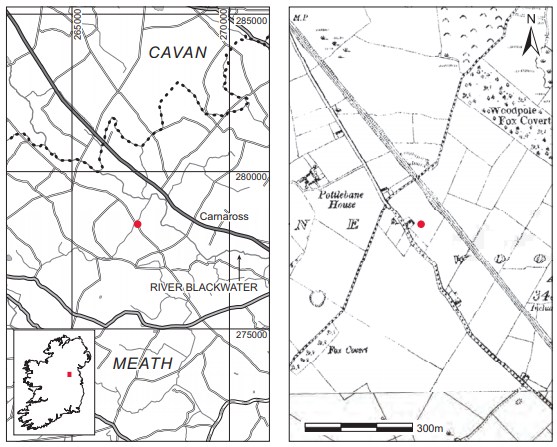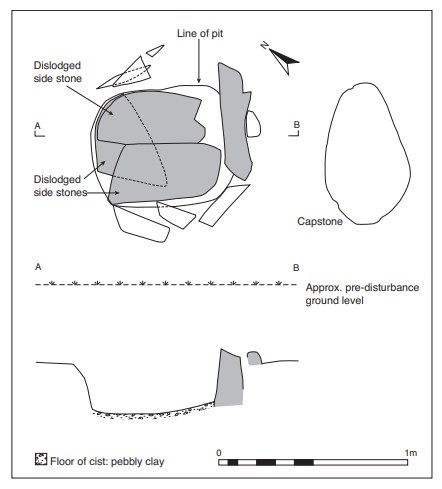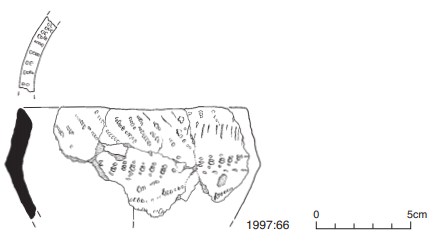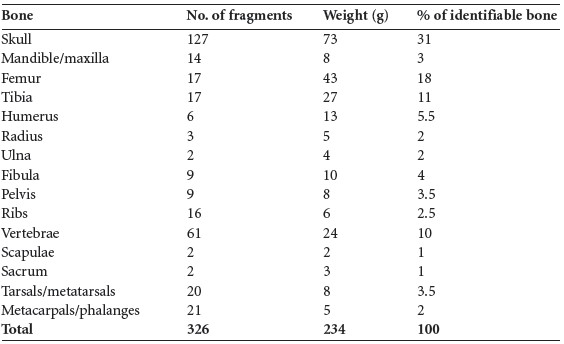County: Meath Site name: WOODPOLE, CO. MEATH
Sites and Monuments Record No.: SMR ME010-043 Licence number: E1144
Author: MARY CAHILL
Site type: Early Bronze Age graves
Period/Dating: —
ITM: E 667029m, N 778349m
Latitude, Longitude (decimal degrees): 53.750459, -6.983700
Introduction
In October 1997 a short cist was discovered during landscaping of a private garden near Kells, Co. Meath. The cist stones had been dislodged by a mechanical digger, and the driver, recognising their significance, stopped work and advised the landowner to contact the relevant authorities. The find was reported to Dr Ann Lynch of Dúchas the Heritage Service, who informed the NMI of the discovery.258 A rescue excavation was carried out the following day (8 October) by Mary Cahill.259 Unfortunately, the cist had been significantly disturbed prior to excavation, probably on a number of different occasions.

Location (Fig. 3.142)
The site was in the townland of Woodpole, north-west Co. Meath, approximately 7km northwest of Kells.260 It lies at an altitude of approximately 90m above sea level just a few metres south of the dismantled Great Northern Railway. No other cist sites are known from the townland.
Description of site
The cist had been severely damaged, with only an end slab and one side intact. Three slabs were visible lying on the surface of the ground. During the course of excavation it became clear that two of these were dislodged side slabs and one was an end slab. Originally, the cist would have been almost square in plan, with its long axis aligned north-west/south-east (Fig. 3.143). The intact cist would have measured approximately 0.66m long by 0.64m wide by 0.3m high and was constructed of a minimum of four edge-set slabs, probably each one forming a cist wall.

Only one stone—the south-eastern end stone—was in situ. The other three stones had collapsed inwards. The extant slab measured 0.62m long by 0.16m thick. A number of support or packing stones were noted outside the south-western side wall and in the northern corner of the cist. The floor of the cist was not paved but consisted of pebbly clay. The capstone of the cist, which had been removed prior to excavation, was oval in shape and measured 0.75m long by 0.45m wide by 0.09m thick. The pit dug to receive the cist was almost square in plan, measuring approximately 0.7m long by 0.65m wide. The contents of the cist had also been disturbed, and only a small quantity of undisturbed cremated bone, the remains of an adult female and a neonate(1997:67), was found on the cist floor. The fact that no further fragments of the bowl (other than those collected by Dr Lynch) were found during excavation would seem to corroborate the view that the contents had been previously disturbed.
Ribbed bowl, 1997:66 (Fig. 3.144)
Fragmentary remains of a ribbed bowl consisting of fifteen sherds—six rim sherds and nine body sherds. The rim is bevelled and decorated with comb impressions. The area below the rim is decorated with slanted lines, some comb-impressed, others plain, incised lines. Below this zone is a rib decorated with comb impressions. Very little of the body of the bowl survives, but random short rows of comb impressions form part of the decoration. The decorative scheme is very poorly executed.

Comment
The human remains from this site have not been dated. The vessel is close in form and decoration to a ribbed bowl from Coolnakilly, Co. Wicklow (Ó Ríordáin and Waddell 1993, 227, no. 348; NMI W2/Wk105). The decoration is also similar to elements of the decoration of the tripartite bowl from Baggotstown, Co. Limerick (this volume, Fig. 3.96), which is assigned by Brindley (2007, 248) to stage 3 of the bowl series. This phase is dated to 1980–1930/20 BC.
HUMAN REMAINS
LAUREEN BUCKLEY
Introduction
Sample 1997:67 consisted of 1,629 fragments of cremated bone, weighing a total of 498g. The bone was white and was efficiently cremated, except for some small fragments that had barely changed colour from the original bone.
Table 3.72—Fragmentation of bone, 1997:67.

The fragmentation of the sample is shown in Table 3.72. It can be seen that, although there is only a small proportion of very large fragments, the medium-sized fragments more than 10mm in length make up over 80% of the sample. The high proportion of medium-sized fragments is probably due to the bone being disturbed twice and broken up in the process. It is likely that there was a high proportion of large fragments originally.
Identifiable bone
The lack of crushing of the bone is reflected in the amount of bone that could be identified (Table 3.73). A total of 891g (71% of the total bone) was identified.
The normal proportions of the different parts of the skeleton are: skull 18.2%; axial skeleton (ribs, vertebrae, pelvis) 23.1%; upper limb 20.6%; lower limb 38.1% (McKinley 1989). These proportions should be the same regardless of the number of individuals present or their age.
Table 3.73—Proportion of identified bone, 1997:67.

Table 3.74—Summary of identified bone, 1997:67.

Table 3.74 summarises the main parts of the skeleton identified from this sample. It can be seen that the proportion of skull is higher than expected and the proportion of lower limb is lower than expected. Nevertheless, considering that the cremation had been disturbed, the proportions are fairly close to those of a normal cremation.
Description of identifiable features of the bones
Skull
Most of the skull fragments were very small and there were only about ten medium-sized fragments present. Most of the fragments were of calvarium, with parietal, occipital and frontal bone present. Also present were a petrous temporal bone and a left temporal fossa. The lateral half of a right orbit possibly from a female or juvenile was present. The external occipital protuberance of the occipital bone did not appear to be very large. Part of the basal occipital bone was also present.
Mandible and maxilla
There was one large piece of the left side of the mandible and several small pieces with one socket each in them. There was also one fragment from near the internal angle and one partial condyle. There were a number of small fragments of maxilla with partial tooth sockets that could not be identified.
Dentition
The following tooth sockets were present:

The roots of at least one incisor and one molar were present, as well as five other fragments of incomplete roots and a partial premolar crown.
Vertebrae
The left and right sides of the neural arch of the first cervical vertebra were present. The body, dens and superior articular surfaces of the second cervical vertebra were present, as well as the bodies of four lower cervical and arches from two lower cervical vertebrae. There were several disarticulated articular surfaces from thoracic vertebrae as well as one almost complete upper thoracic body. There were three fragments of lumbar bodies and a few articular surfaces. An almost complete body of the first sacral vertebra and part of the body of the second sacral vertebra were present. One fragment of vertebral body showed slight osteophytosis but the others had no pathology present.
Ribs
Mostly small fragments of shaft, but some fragments close to the head from at least three ribs.
Pelvis
Mainly fragments of ilium, including a fragment of acetabulum, a fragment of iliac crest and a fragment of pubic bone.
Scapulae
Part of an acromial spine and a fragment of glenoid area were present.
Humerus
This consisted mainly of fragments of shaft, including the proximal shaft, and one fragment of distal joint surface.
Radius
Fragments from the distal third of the shaft were present.
Ulna
Two fragments from the distal shaft were present.
Metacarpals and phalanges
The head of a first metacarpal and heads of two other metacarpals were present, as well as two partial carpal bones. There were also six proximal, three middle and three distal hand phalanges.
Femur
All except one of the fragments were from the shaft. The largest fragment was 64mm long and 6mm thick. A few pieces had traces of the linea aspera present, although it was not well developed. There was one fragment of the distal articular surface.
Tibia
All the fragments were shaft fragments, including some of the medial border and the proximal posterior part of the shaft with the nutrient foramen visible.
Fibula
One large fragment from the proximal third of the shaft was present, as well as one fragment near the distal third. Other small fragments of shaft were present, as well as one fragment of distal joint surface.
Tarsals/metatarsals
At least one talus, one navicular, one cuneiform and a metatarsal shaft were present, along with three middle and two distal foot phalanges.
Infant bones
A number of bones from a neonate or very small infant were present. These included two vertebral centra and a half-arch, the glenoid area of a right scapula and a tiny fragment of mandible with the base of three partial tooth sockets present:

Minimum number of individuals
The main content of the cremation was from one adult, probably a female. Also present were the remains of an infant, probably a neonate but certainly no more than six months old at the time of death.
Summary and conclusions
This sample of 495g of cremated bone was much smaller than expected from a complete adult cremation. It was, however, efficiently cremated, but as it had been disturbed and broken up it was not possible to say anything with regard to the treatment of the bone at the time of cremation and original disposal. It was possible to identify 48% of the bone and the proportions of the various parts of the skeleton were in keeping with what would be expected from a normal cremation.
Most of the remains were from one individual, an adult female. The slight degree of osteophytosis on one vertebra only suggests that she might have been aged 20–30 years at the time of death. Also present in the cremation was a very small amount of infant bone, probably from a neonate.
258. A number of sherds of a bowl (1997:66) and some cremated bone were recovered by Dr Lynch.
259. Assisted by Jacqueline MacDermott.
260. Parish of Loughan or Castlekeeran, barony of Upper Kells. SMR ME010-043——. IGR 267093 278333.